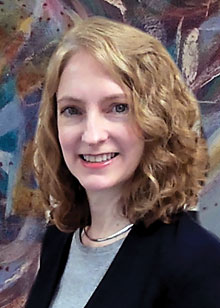For years, many have hoped that magnetic seizure therapy (MST) could become a promising clinical alternative to electroconvulsive therapy (ECT), successfully treating patients with severe depression with fewer side effects. Research is still
underway to see if MST delivers on that promise, and a new study has taken the research one step further.
In the largest trial to date comparing MST and ECT, Sarah H. Lisanby, M.D., and her colleagues showed that MST is as effective as ECT at achieving lasting antidepressant effects in people with major depression. The
study, published in
JAMA Psychiatry, also showed that patients who received MST required less time to orient themselves following the procedure compared with those who received ECT. Time to orientation following ECT is associated with memory loss, one of the side effects that can deter patients from choosing the therapy, Lisanby explained. She is the director of the Division of Translational Research and the director of the Noninvasive Neuromodulation Unit at the National Institute of Mental Health.
Lisanby said she is optimistic that MST may prove to be an effective, safe alternative to ECT for many patients in need. “The current suicide rates are devastating and unacceptable,” she said. “We know that treatments like ECT are rapidly effective in reversing suicidal thoughts and in preserving life for our most severely depressed patients. What remains a barrier to many patients in receiving potentially lifesaving ECT are the side effects and stigma. If we could do away with the side effects altogether, we would remove one of the major barriers that is preventing people who could benefit from seizure therapies from receiving treatment.”
Lisanby and her colleagues conducted the trial among participants aged 18 to 90 years who were referred for ECT treatment. The participants had all experienced a major depressive episode and had a diagnosis of major depressive disorder or bipolar disorder. They had a baseline score of 18 or higher on the 24-item Hamilton Depression Rating Scale (HDRS-24). Participants were assigned to receive either MST or right unilateral ultrabrief pulse ECT at six times the seizure threshold, after which they were followed for up to six months.
Lisanby emphasized that this study was comparing MST with what she called “the gold standard” of ECT. Right unilateral ultrabrief pulse ECT at six times the seizure threshold is the safest form of ECT that is clinically available and does not sacrifice efficacy, she said.
Among 73 patients, 35 were randomized to MST and 38 to ECT. Participants in both groups received treatment three times a week until they achieved remission (defined as at least 60% reduction in HDRS-24 score and a total score of no more than 8) or until their HDRS-24 scores plateaued for at least three treatment sessions starting after the eighth treatment. Participants were considered to have completed treatment if they had received at least eight treatments or achieved remission prior to the eighth treatment.
Adverse effects were evaluated after each treatment session using the Columbia ECT Subjective Side Effects Schedule. The time it took participants to orient themselves following treatment was assessed after each session by having patients open their eyes on command and correctly answer personal identification questions, such as their name, age, and date of birth. Depression severity was measured with the HDRS-24 the morning of each treatment session, 24 to 72 hours after the last treatment session, twice a month for the first two months after treatment, and once a month thereafter for six months.
Both MST and ECT demonstrated clinically meaningful antidepressant effects, with participants in both groups starting with an average baseline HDRS-24 score of about 30, which then reduced to about 18 by the eighth treatment. The antidepressant benefit participants experienced at the end of treatment, as measured by the HDRS-24 score, was maintained at the two-month and six-month follow-ups. Additional findings included the following:
•
53 participants completed treatment, including 29 in the MST group and 24 in the ECT group.
•
45% of participants in the MST group and 42% of participants in the ECT group met remission criteria.
•
The mean number of treatments needed to achieve remission was 9.0 in the MST group and 6.7 in the ECT group.
•
On average, it took the MST participants a few minutes to orient themselves, compared with almost 20 minutes for the ECT participants.
•
Five serious adverse events were reported, all in the ECT group, including three cases of worsening depression that resulted in hospitalization. In the MST group, four adverse events were reported including nausea and vomiting after treatment.
Lisanby and her colleagues are working on another publication based on the data from this study. In the second paper, they will analyze the results of an extensive battery of tests that are more sensitive to the neurocognitive effects of ECT, she said. The follow-up publication will provide more detailed data on how MST compares with ECT in terms of ECT’s side effects, such as memory loss.
She also noted that, while this was the largest randomized, controlled trial to date, it does not definitively prove that MST is noninferior to ECT. “Just because we didn’t find a difference in our paper with 73 patients doesn’t mean that smaller differences wouldn’t be detected in a larger trial,” she said. The noninferiority trial is known as CREST-MST (Confirmatory Efficacy and Safety Trial of Magnetic Seizure Therapy for Depression) and is ongoing.
There is still a lot more work to be done before MST becomes widely available to patients, Lisanby said. “It remains investigational, but the results of our study are at least very helpful and promising.”
The study was supported by grants from the Stanley Medical Research Foundation, the National Institute of Mental Health, and the National Center for Advancing Translational Sciences, as well as a Young Investigator Award from the Brain and Behavior Research Foundation. ■

